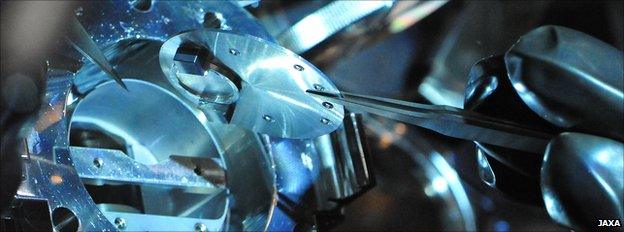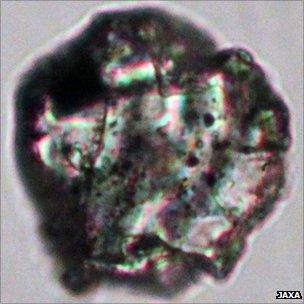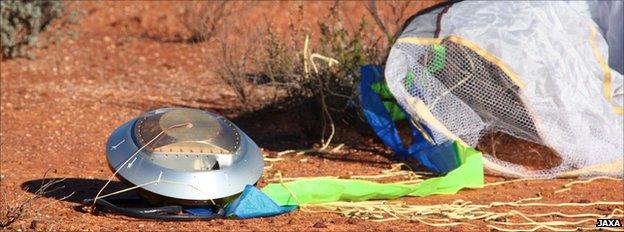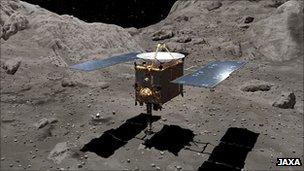Solar System history written in dust
- Published
- comments

Hayabusa's sample catcher is removed from its sterile capsule
So much from so little. When Japanese scientists opened the sterile canister from their sample-return mission to Asteroid Itokawa, they dared to hope they would have something to analyse.
They did - more than a thousand rocky fragments, but none of them bigger than a couple of tenths of a millimetre across. But with today's powerful laboratory tools, this mini-haul proved just ample, and, in the current edition of Science magazine, external, the Hayabusa mission-scientists report their key findings.
The headline discovery - the one I guess that has most significance to the wider research community - is the confirmation that S-type asteroids, external, as objects like Itokawa are known, are the source for most of the small meteorites that fall to Earth - rocks labelled as ordinary chondrites, external.
Everyone suspected that to be the case but the absolute proof wasn't there - until now.

The fragments of Itokawa dust are tiny. This one is just 50 thousandths of a millimetre across
Whenever scientists examined the chemistry in these meteorites in the lab and then compared what they saw to their observations of the S-type asteroids made through telescopes, there was always a slight mismatch.
The suspicion was that the surfaces of these space rocks were being subtly altered by sitting out in the solar wind, the stream of charged particles billowing off the Sun; and that their "suntan" was hiding their true chemistry.
Well, the dust fragments picked up off the surface of Itokawa show that to be so. Case closed.
What I find really fascinating, however, are some of the discoveries that come just below this S-type headline.
Scientists have established that the surface materials on Itokawa have at some stage experienced long-term heating up at 800 degrees, something unlikely to have happened on a body so small (the asteroid currently is only some 500m across).
The implication therefore is that Itokawa is actually the remnants of a much larger asteroid (bigger than 20km across) that was broken up. It is the classic rubble pile that has been swept up and reassembled into a small jumbled heap by gravity.

On its return to Earth, the Hayabusa sample capsule landed in Australia's Outback
The samples also hint at a rather depressing future for this pile. The scientists have looked at how the returned particles have been altered by "space weathering, external" - changes brought about by impacts from cosmic rays, those solar wind particles and even other fragments of dust.
They find that the particles have been exposed to this weathering for no more than eight million years.
This implies either that Itokawa coalesced just eight million years ago, or, as seems more likely, its surface is eroding at a rate of several centimetres every million years to expose fresh material. That makes sense because, being so small, there is little gravity to hold this object together and even the slightest disturbance will lift dust away from the asteroid.
If this process continues, Itokawa will disappear from view completely within a billion years.
This is one of those serendipitous discoveries. You'll remember that the Hayabusa spacecraft's sample-grabbing mechanism didn't work properly. The fragments that were retrieved drifted into the sample canister simply by virtue of the spacecraft bumping into Itokawa.

The Japanese are promising a follow-up mission to Hayabusa
As Trevor Ireland, a co-researcher and a professor of Earth chemistry at the Australian National University, recalls: "The original intent was for a gun to fire into the surface of Itokawa when Hayabusa touched down, with the ejected sample collected into the sample chamber.
"This would have provided us with a bulk sample of the asteroid to analyse. However, a software interlock prevented the gun from firing. This was seen as disappointing in that we did not get as much material returned as was intended.
"In hindsight though, a bulk sample would not necessarily have provided the same information as we have obtained from these small dust grains that sat on the very surface of the asteroid. These were the samples we really wanted and these have been delivered back to us."
So all this and more from Hayabusa which must be declared an extraordinary success (ignore the series of technical hiccups it experienced in the course of its seven year adventure).
"The cool thing about this Itokawa analysis is the tremendous amount of data we can get from such a small sample," says Michael Zolensky from Nasa's Johnson Space Center in Houston, Texas.
"When researchers analysed regolith from the Moon, they needed kilogram-sized samples. But, for the past 40 years, experts have been developing technologies to analyse extremely small samples. Now, we've gained all this information about Itokawa with only a few nano-grams of dust from the asteroid."
The Itokawa results underline once again the power of sample return missions. It is only by getting rock samples into a fully tooled Earth laboratory that the hardest questions can be addressed. This will be especially true of the life question at Mars.
Take a look at the story I wrote on Monday about the oldest, best preserved fossil microbes found on Earth.
It took four years of intense investigation using some instruments that filled a room to get a confident description of these fossils.
The progress of miniaturisation has been remarkable, but it is hard to imagine that robotic rovers will ever make irrefutable discoveries of life on other planets.
That kind of eureka moment will only occur when returned samples are subjecting to the full panoply of modern analytical techniques here on Earth.
- Published28 May 2011
- Published16 November 2010
- Published13 June 2010